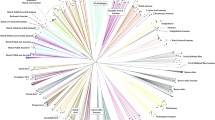Summary
The pedigrees of birds in a poultry flock under artificial selection were analysed to trace the spread of genes from original flock members.
The changes in gene percentage from generation to generation were separated into parts attributed to chance, natural and artificial selection.
The changes due to artificial selection were related to various production characters. The spread of the male’s genes was 70% determined by a progeny test which also 25% determined the spread of genes of birds mated to him. The progeny test of the female did not contribute equally to determination of the gene spread. This was attributed to lesser accuracy of the female progeny test and less complete determination of spread of genes by value of genotype.
Despite avoidance of sib matings, inbrecding has increased 2% per generation.
Evidence that natural selection was opposing artificial selection was suggestive but inconclusive.
It was suggested that assortative mating would increase the determination of gene spread by genotypic value. This was considered worth testing.
Similar content being viewed by others
References
Clayton, G. A. &Robertson, A. (1957). An Experimental Check on Quantitative Genetical Theory. II. The Long-Term Effects of Selection.J. Genet.,55, 152–170.
Lerner, I. M. (1950). “Population Genetics and Animal Improvement.” Cambridge University Press.
Lerner, I. M. &Hazel, L. N. (1947). Population Genetics of a Poultry Flock under Artificial Selection.Genetics,32, 325–339.
Lush, J. L. &Anderson, A. L. (1939). A Genetic History of Poland China Swine. II. “Founders of the Breed”, Prominent Individuals, Length of Generation.J. Heredity,30, 219–24.
Osborne, R. (1957). The Use of Sire and Dam Family Averages in Increasing Efficiency of Selective Breeding under a hierarchical Mating System.Heredity,11, 93–116.
Robertson, A. &Asker, A. A. (1951). The Genetic History and Breed Structure of British Friesian Cattle.Exmp. J. Exp. Agric.,19, 113–130.
Shoffner, R. N.,Sloan, H. J.,Winters, L. M.,Canfield, I. H. &Pilkey, A. M. (1953). Development and Performance of Inbred Lines of Chickens.Tech. Bull. No. 207, Univ. Minnesota Agric. Exp. Sta.
Wiener, G. (1953). Breed Structure in the Pedigree Ayrshire Cattle Population in Great Britain.J. Agric. Sci.,43, 123–130.
Willham, O. S. (1937). A Genetic History of Hereford Cattle in the United States.J. Heredity,28, 283–294.
Wright, S. &McPhee, H. C. (1925). An Approximate Method of Calculating Coefficients of Inbreeding and Relationship from Livestock Pedigrees.J. Agric. Res.,31, 377–83.
Yoder, D. M. &Lush, J. L. (1937). A Genetic History of the Brown Swiss Cattle in the United States.J. Heredity,28, 154–160.
Author information
Authors and Affiliations
Rights and permissions
About this article
Cite this article
James, J.W., McBride, G. The spread of genes by natural and artificial selection in closed poultry flock. J Genet 56, 55–62 (1958). https://doi.org/10.1007/BF02984720
Issue Date:
DOI: https://doi.org/10.1007/BF02984720




